We use cookies on our website to provide you with the best possible service and to further improve our website. By clicking the "Accept All" button, you agree to the use of all cookies. You can limit the cookies used by clicking on "Accept selection". Further information and an option to revoke your selection can be found in our privacy policy.
These cookies are necessary for basic functionality. This allows you to register on our website and forum or order products with our online shop.
With these cookies, we collect anonymized usage data for our website. For example, we can see which content is interesting for our visitors and which resolutions are used. We use the information to optimize our website to provide you with the best possible user experience.
show more
All prices are plus the at present valid value added tax!
We gladly accept pre-orders (order@peak-system.com). Please note our information about the delivery situation.
The PCAN-Ethernet Gateway FD DR allows access to classic CAN or modern CAN FD buses via an IP network. On top of that, CAN buses can be connected to each other via IP using multiple devices. CAN frames are wrapped in TCP or UDP message packets and then forwarded via the IP network from one device to another. The PCAN-Ethernet Gateway FD DR provides a LAN interface and two CAN FD interfaces that allow bit rates up to 10 Mbit/s. For this, an AM5716 Sitara processor provides the needed performance.
The PCAN Gateway product family is configured via a convenient web interface. Alternatively, the JSON interface allows access via software. Both options provide status information and settings of the devices, the various communication interfaces, message forwarding, and filters.
The CAN FD standard (CAN with Flexible Data rate) is primarily characterized by higher bandwidth for data transfer. The maximum of 64 data bytes per CAN FD frame (instead of 8 so far) can be transmitted with bit rates up to 10 Mbit/s. CAN FD is downward-compatible to the CAN 2.0 A/B standard, thus CAN FD nodes can be used in existing CAN networks. However, in this case the CAN FD extensions are not applicable.
 With the PCAN-Gateways, CAN buses can be connected via LAN or WLAN. CAN frames are wrapped into TCP or UDP message packets and then forwarded from one device to another. Based on this technology, it is possible to connect CAN networks over a great distance.
With the PCAN-Gateways, CAN buses can be connected via LAN or WLAN. CAN frames are wrapped into TCP or UDP message packets and then forwarded from one device to another. Based on this technology, it is possible to connect CAN networks over a great distance.
The configuration of the PCAN-Gateway product family is done via a convenient web interface. For this, the device must be connected to the PC via LAN or WLAN, depending on the used model. The web interface can be opened with a common browser. After a successful login you get access to all information and the configuration of the device settings, communication interfaces, message forwarding, and filters.
Alternatively, the JSON interface is available for access. This allows the development of software to automatically monitor and configure all devices connected to the IP network.

This package is used to update the software and configuration website of the PCAN-Ethernet Gateway FD DR (IPEH-004012).
This package contains sample code and a Wireshark dissector to support the development of socket applications connecting to a PCAN-Gateway.
This is the PEAK-System installation package for device drivers and tools for Windows® 11 (x64/ARM64), 10 (x64).
Please note: Select the Virtual PCAN-Gateway from the available options during the installation.